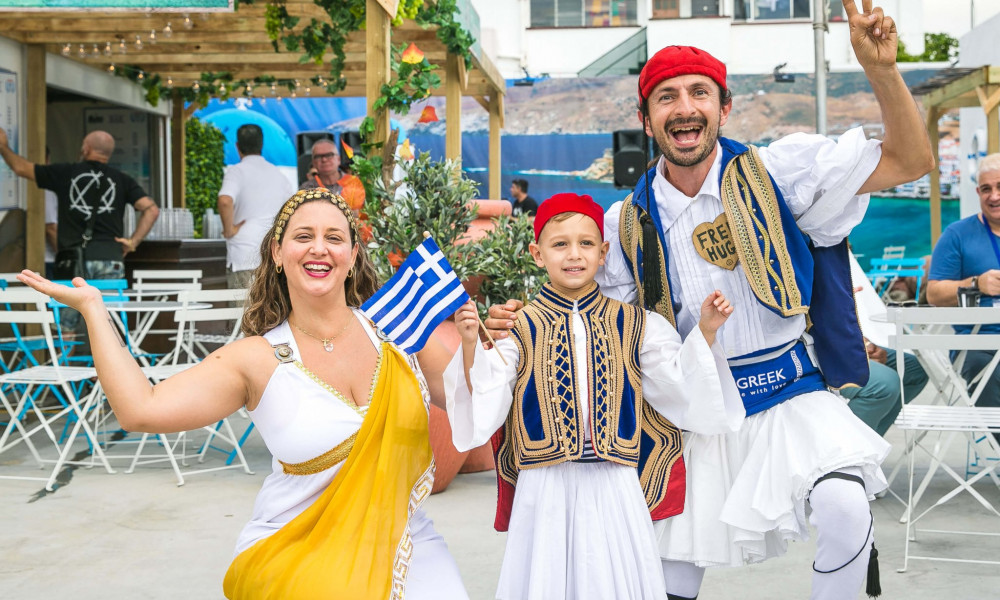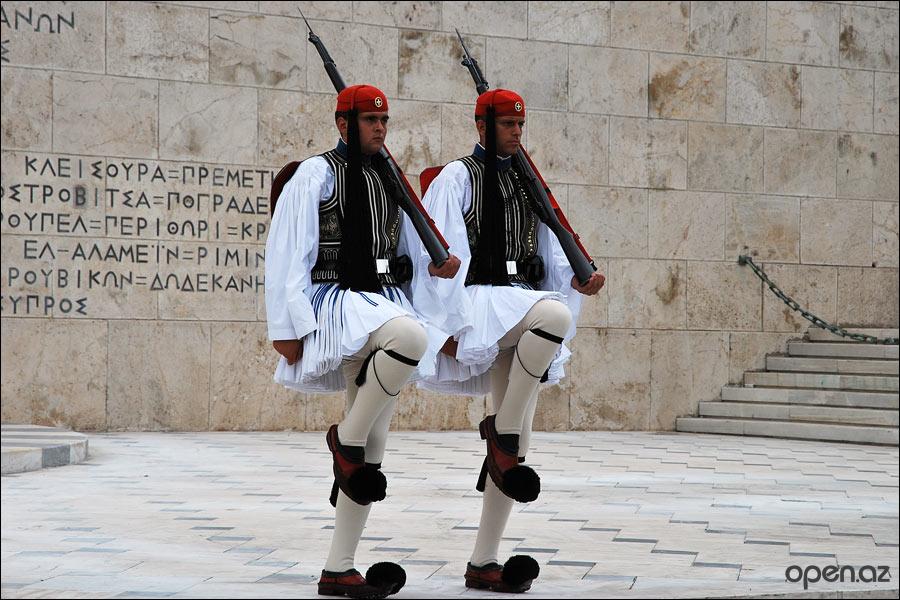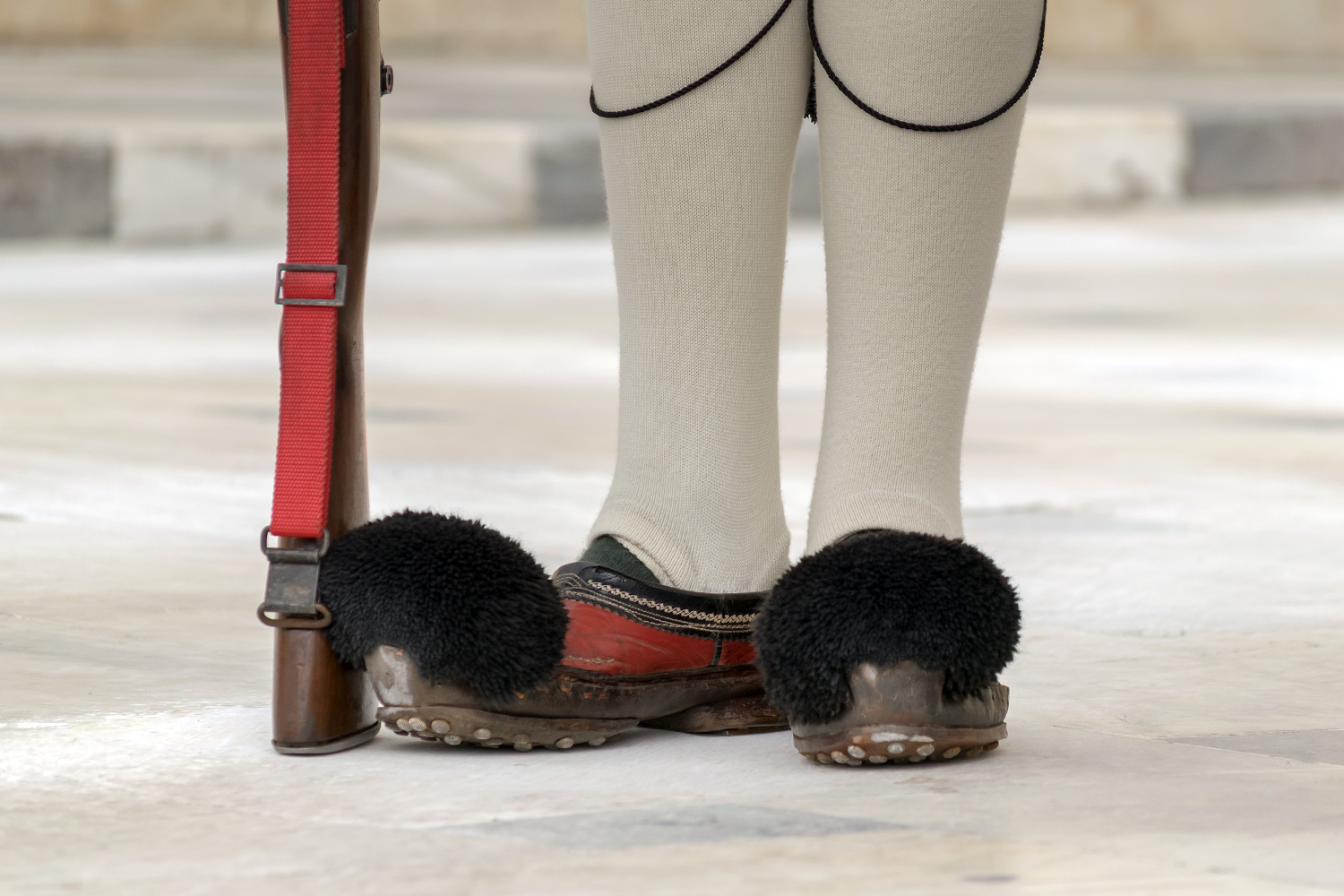On the catwalk: Greece

Should you ask Tom, Dick and Harry how a Greek national costume looks, you’ll most likely hear a description of ancient Greek fashion with its elegant drapery and light wicker sandals. No surprise there because this is the exact image that is most often depicted in movies and described in books. Dresses of pagan Greece reflected common aesthetic ideals. Simple appearance was supposed to emphasize beauty and richness of inner world while drapery – freedom of movement for a proportional and trained body. Noble citizens added expensive jewelry and rich embroidery however both fabric and design remained simple without fail.
Photo greece-is.com
Main clothes of Greek man were chiton and himation. Both were pieces of fabric, skillfully draped and linked with fibula buckles. Chiton was folded vertically along left side and fixed on shoulders. On the sides it was either sewn or left open on one of them. Length could vary but most popular version was knee-long. As to himation, it was a prototype of overclothes. Cut of a woolen fabric about two by four meters was draped around one’s body to fit its shape; and for the free end of the fabric not to slip, when thrown over one’s shoulder, pieces of lead were sewn inside. By the way, men of Sparta didn’t wear chitons, their sternness allowed them wear himations next to skin. But they were men of Sparta for a reason, famous for their stamina. Another type of overclothes was chlamys: also a piece of fabric that was thrown on one’s shoulders and fixed with a buckle. It is most often associated with military leaders who wore amaranth-colored chlamyses. Photo backstreetbrisbane.com
Photo backstreetbrisbane.com
Women in ancient Greece used same chitons and himations in their wardrobe but had them brighter and more diverse. At that, huge attention was paid to creating proportions of a body using turnout of chiton’s upper end – diplodius. It also played decorative role and could have different colors, it was decorated with ornamentation or embroidery. Just like men’s chitons, women’s ones were linked on shoulders with fibulae and belted with colpos. Main distinction of women’s outfits was richness of colors, ornamentation and decoration. Sandals were adorned with gold and silver, hairstyles – with bands and flowers. Photo ctpost.com
Photo ctpost.com
Such fashion was relevant before transfer to Orthodox Christianity. Together with it, body-hiding clothes came into vogue, sandals were replaced with shoes and decorated hairstyles with heavy headdresses. In this period numerous brand-new national costumes for various social layers and regions emerged. While differing in detail, they all had things in common. Photo twitter.com
Photo twitter.com
Despite hot climate, traditional Greek clothes in Christian times were distinctive for having many layers, a lot of volume and being made of materials that would easily fit colder climate. Numerous pleats, pompoms and fringe seemingly served purely decorative purposes. However, there is a version that Greeks, who were normally peace-loving, used to hide weapons in grand clothes, ready to turn from countrymen into armed defenders of their homeland. Photo ctpost.com
Photo ctpost.com
One of the most famous men’s traditional outfits – Fustanella Tsolias – is still used for the National Guard. It is worn by soldiers of Presidential Regiment in Athens. Its key element is white-colored skirt called fustanella that consists of several fabric cuts and 400 pleats that symbolizes number of years under the yoke of the Ottoman Empire. White wide-sleeved shirt, wide belt and a vest are also required in the outfit. Evzones of the Presidential Regiment wear burgundy-colored vests although there are also black and blue versions. Most unusual element from modern point of view is footwear. Large tsarouhias with huge pompoms are shoed with heavy nails for steps of Evzones to be audible well. With such shoes each tsarouhia can weigh up to five kilograms although they don’t seem cumbersome or too heavy to lift by the look of them.  Photo open.az
Photo open.az
Another men’s national costume is vraka. It has same white-colored wide-sleeved shirt complete with undergarment called panavaki, black baggy trousers karamani, yellow vest koumbouri, outer jacket, long and wide belt with fringes and a hairdress called megalo fesi that resembles a cap. One would think that in warm climate chitons were supposed to catch on much better, but no, it is vraka of all other garments that is one of the most popular costumes in entire Greece and even nowadays it can be often seen during holidays and weddings. Photo backstreetbrisbane.com
Photo backstreetbrisbane.com
Women’s costumes differ from the ones for men in terms of number of layers and complexity. Most popular ones are desfina and karagouna. The former was specific for countrywomen and consisted of long white dress, embroidered vest, red velvet apron with gold embroidery and white kerchief with fringes. The latter one, karagouna, often served as a wedding garment. It was considered in the lead in terms of number of layers. There was white under-dress, bright wollen coat, long red apron that covers skirt on both sides, velvet oversleeves and a large kercheif with fringes and monist to cover head. Due to numerous elements and decorations karagouna could be so heavy that women could barely walk or even move their head. Photo img-fotki.yandex.ru
Photo img-fotki.yandex.ru
Nowadays Greeks can afford reducing number of layers in clothing significantly and approach ancient aesthetic ideals to a certain extent that is supposed to emphasize gracefulness and dexterity of human body. Simplicity is in vogue again and although it doesn't take shape of chitons but modern dresses and light jeans that don't hinder movement. However, it doesn't mean that multi-layered garments with fringes are forgotten: they can still be seen if not in everyday life than at least during national holidays.
Cover photo westendmagazine.com



















